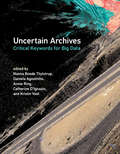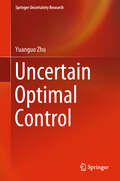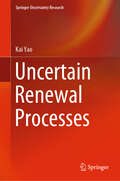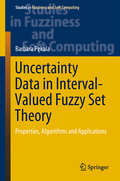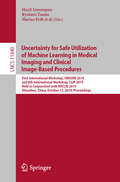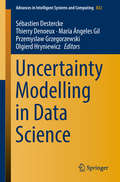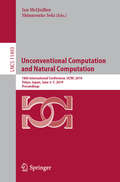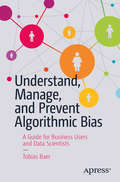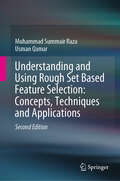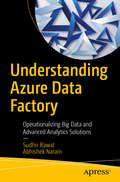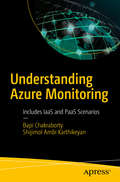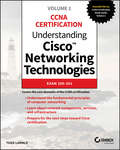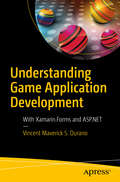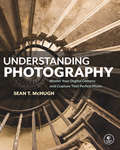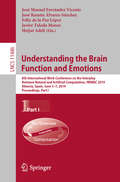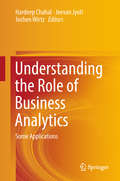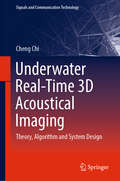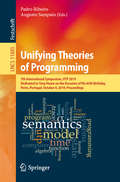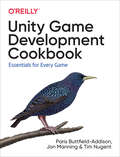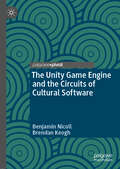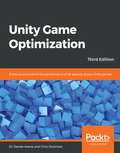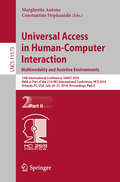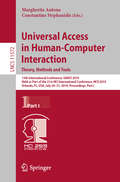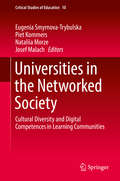- Table View
- List View
Uncertain Archives: Critical Keywords for Big Data
by Nanna Bonde Thylstrup Daniela Agostinho Annie Ring Catherine D'Ignazio Kristin VeelScholars from a range of disciplines interrogate terms relevant to critical studies of big data, from abuse and aggregate to visualization and vulnerability.This pathbreaking work offers an interdisciplinary perspective on big data, interrogating key terms. Scholars from a range of disciplines interrogate concepts relevant to critical studies of big data--arranged glossary style, from from abuse and aggregate to visualization and vulnerability--both challenging conventional usage of such often-used terms as prediction and objectivity and introducing such unfamiliar ones as overfitting and copynorm. The contributors include both leading researchers, including N. Katherine Hayles, Johanna Drucker and Lisa Gitelman, and such emerging agenda-setting scholars as Safiya Noble, Sarah T. Roberts and Nicole Starosielski.
Uncertain Optimal Control (Springer Uncertainty Research Ser.)
by Yuanguo ZhuThis book introduces the theory and applications of uncertain optimal control, and establishes two types of models including expected value uncertain optimal control and optimistic value uncertain optimal control. These models, which have continuous-time forms and discrete-time forms, make use of dynamic programming. The uncertain optimal control theory relates to equations of optimality, uncertain bang-bang optimal control, optimal control with switched uncertain system, and optimal control for uncertain system with time-delay. Uncertain optimal control has applications in portfolio selection, engineering, and games. The book is a useful resource for researchers, engineers, and students in the fields of mathematics, cybernetics, operations research, industrial engineering, artificial intelligence, economics, and management science.
Uncertain Renewal Processes (Springer Uncertainty Research)
by Kai YaoThis book explores various renewal processes in the context of probability theory, uncertainty theory and chance theory. It also covers the applications of these renewal processes in maintenance models and insurance risk models. The methods used to derive the limit of the renewal rate, the reward rate, and the availability rate are of particular interest, as they can easily be extended to the derivation of other models. Its comprehensive and systematic treatment of renewal processes, renewal reward processes and the alternating renewal process is one of the book’s major features, making it particularly valuable for readers who are interested in learning about renewal theory. Given its scope, the book will benefit researchers, engineers, and graduate students in the fields of mathematics, information science, operations research, industrial engineering, etc.
Uncertainty Data in Interval-Valued Fuzzy Set Theory: Properties, Algorithms and Applications (Studies in Fuzziness and Soft Computing #367)
by Barbara PękalaThis book offers an introduction to fuzzy sets theory and their operations, with a special focus on aggregation and negation functions. Particular attention is given to interval-valued fuzzy sets and Atanassov’s intuitionistic fuzzy sets and their use in uncertainty models involving imperfect or unknown information. The theory and application of interval-values fuzzy sets to various decision making problems represent the central core of this book, which describes in detail aggregation operators and their use with imprecise data represented as intervals. Interval-valued fuzzy relations, compatibility measures of interval and the transitivity property are thoroughly covered. With its good balance between theoretical considerations and applications of originally developed algorithms to real-world problem, the book offers a timely, inspiring guide to mathematicians and engineers developing new decision making models or implementing/applying existing ones to a wide range of applications involving imprecise or incomplete data.
Uncertainty for Safe Utilization of Machine Learning in Medical Imaging and Clinical Image-Based Procedures: First International Workshop, UNSURE 2019, and 8th International Workshop, CLIP 2019, Held in Conjunction with MICCAI 2019, Shenzhen, China, October 17, 2019, Proceedings (Lecture Notes in Computer Science #11840)
by Hayit Greenspan Ryutaro Tanno Marius Erdt Tal Arbel Christian Baumgartner Adrian Dalca Carole H. Sudre William M. Wells Klaus Drechsler Marius George Linguraru Cristina Oyarzun Laura Raj Shekhar Stefan Wesarg Miguel Ángel González BallesterThis book constitutes the refereed proceedings of the First International Workshop on Uncertainty for Safe Utilization of Machine Learning in Medical Imaging, UNSURE 2019, and the 8th International Workshop on Clinical Image-Based Procedures, CLIP 2019, held in conjunction with MICCAI 2019, in Shenzhen, China, in October 2019. For UNSURE 2019, 8 papers from 15 submissions were accepted for publication. They focus on developing awareness and encouraging research in the field of uncertainty modelling to enable safe implementation of machine learning tools in the clinical world. CLIP 2019 accepted 11 papers from the 15 submissions received. The workshops provides a forum for work centred on specific clinical applications, including techniques and procedures based on comprehensive clinical image and other data.
Uncertainty Modelling in Data Science (Advances in Intelligent Systems and Computing #832)
by Sébastien Destercke Thierry Denoeux María Ángeles Gil Przemyslaw Grzegorzewski Olgierd HryniewiczThis book features 29 peer-reviewed papers presented at the 9th International Conference on Soft Methods in Probability and Statistics (SMPS 2018), which was held in conjunction with the 5th International Conference on Belief Functions (BELIEF 2018) in Compiègne, France on September 17–21, 2018. It includes foundational, methodological and applied contributions on topics as varied as imprecise data handling, linguistic summaries, model coherence, imprecise Markov chains, and robust optimisation. These proceedings were produced using EasyChair.Over recent decades, interest in extensions and alternatives to probability and statistics has increased significantly in diverse areas, including decision-making, data mining and machine learning, and optimisation. This interest stems from the need to enrich existing models, in order to include different facets of uncertainty, like ignorance, vagueness, randomness, conflict or imprecision. Frameworks such as rough sets, fuzzy sets, fuzzy random variables, random sets, belief functions, possibility theory, imprecise probabilities, lower previsions, and desirable gambles all share this goal, but have emerged from different needs.The advances, results and tools presented in this book are important in the ubiquitous and fast-growing fields of data science, machine learning and artificial intelligence. Indeed, an important aspect of some of the learned predictive models is the trust placed in them. Modelling the uncertainty associated with the data and the models carefully and with principled methods is one of the means of increasing this trust, as the model will then be able to distinguish between reliable and less reliable predictions. In addition, extensions such as fuzzy sets can be explicitly designed to provide interpretable predictive models, facilitating user interaction and increasing trust.
Unconventional Computation and Natural Computation: 18th International Conference, UCNC 2019, Tokyo, Japan, June 3–7, 2019, Proceedings (Lecture Notes in Computer Science #11493)
by Shinnosuke Seki Ian McQuillanThis book constitutes the proceedings of the 18th International Conference on Unconventional Computation and Natural Computation, UCNC 2019, held in Tokyo, Japan, in June 2019.The 19 full papers presented were carefully reviewed and selected from 32 submissions. The papers cover topics such as hypercomputation; chaos and dynamical systems based computing; granular, fuzzy and rough computing; mechanical computing; cellular, evolutionary, molecular, neural, and quantum computing; membrane computing; amorphous computing, swarm intelligence; artificial immune systems; physics of computation; chemical computation; evolving hardware; the computational nature of self-assembly, developmental processes, bacterial communication, and brain processes.
Understand, Manage, and Prevent Algorithmic Bias: A Guide for Business Users and Data Scientists
by Tobias BaerAre algorithms friend or foe?The human mind is evolutionarily designed to take shortcuts in order to survive. We jump to conclusions because our brains want to keep us safe. A majority of our biases work in our favor, such as when we feel a car speeding in our direction is dangerous and we instantly move, or when we decide not take a bite of food that appears to have gone bad. However, inherent bias negatively affects work environments and the decision-making surrounding our communities. While the creation of algorithms and machine learning attempts to eliminate bias, they are, after all, created by human beings, and thus are susceptible to what we call algorithmic bias.In Understand, Manage, and Prevent Algorithmic Bias, author Tobias Baer helps you understand where algorithmic bias comes from, how to manage it as a business user or regulator, and how data science can prevent bias from entering statistical algorithms. Baer expertly addresses some of the 100+ varieties of natural bias such as confirmation bias, stability bias, pattern-recognition bias, and many others. Algorithmic bias mirrors—and originates in—these human tendencies. Baer dives into topics as diverse as anomaly detection, hybrid model structures, and self-improving machine learning. While most writings on algorithmic bias focus on the dangers, the core of this positive, fun book points toward a path where bias is kept at bay and even eliminated. You’ll come away with managerial techniques to develop unbiased algorithms, the ability to detect bias more quickly, and knowledge to create unbiased data. Understand, Manage, and Prevent Algorithmic Bias is an innovative, timely, and important book that belongs on your shelf. Whether you are a seasoned business executive, a data scientist, or simply an enthusiast, now is a crucial time to be educated about the impact of algorithmic bias on society and take an active role in fighting bias.What You'll LearnStudy the many sources of algorithmic bias, including cognitive biases in the real world, biased data, and statistical artifactUnderstand the risks of algorithmic biases, how to detect them, and managerial techniques to prevent or manage themAppreciate how machine learning both introduces new sources of algorithmic bias and can be a part of a solutionBe familiar with specific statistical techniques a data scientist can use to detect and overcome algorithmic biasWho This Book is ForBusiness executives of companies using algorithms in daily operations; data scientists (from students to seasoned practitioners) developing algorithms; compliance officials concerned about algorithmic bias; politicians, journalists, and philosophers thinking about algorithmic bias in terms of its impact on society and possible regulatory responses; and consumers concerned about how they might be affected by algorithmic bias
Understanding and Using Rough Set Based Feature Selection: Concepts, Techniques and Applications
by Muhammad Summair Raza Usman QamarThis book provides a comprehensive introduction to rough set-based feature selection. Rough set theory, first proposed by Zdzislaw Pawlak in 1982, continues to evolve. Concerned with the classification and analysis of imprecise or uncertain information and knowledge, it has become a prominent tool for data analysis, and enables the reader to systematically study all topics in rough set theory (RST) including preliminaries, advanced concepts, and feature selection using RST. The book is supplemented with an RST-based API library that can be used to implement several RST concepts and RST-based feature selection algorithms.The book provides an essential reference guide for students, researchers, and developers working in the areas of feature selection, knowledge discovery, and reasoning with uncertainty, especially those who are working in RST and granular computing. The primary audience of this book is the research community using rough set theory (RST) to perform feature selection (FS) on large-scale datasets in various domains. However, any community interested in feature selection such as medical, banking, and finance can also benefit from the book. This second edition also covers the dominance-based rough set approach and fuzzy rough sets. The dominance-based rough set approach (DRSA) is an extension of the conventional rough set approach and supports the preference order using the dominance principle. In turn, fuzzy rough sets are fuzzy generalizations of rough sets. An API library for the DRSA is also provided with the second edition of the book.
Understanding Azure Data Factory: Operationalizing Big Data And Advanced Analytics Solutions
by Sudhir Rawat Abhishek NarainImprove your analytics and data platform to solve major challenges, including operationalizing big data and advanced analytics workloads on Azure. You will learn how to monitor complex pipelines, set alerts, and extend your organization's custom monitoring requirements.This book starts with an overview of the Azure Data Factory as a hybrid ETL/ELT orchestration service on Azure. The book then dives into data movement and the connectivity capability of Azure Data Factory. You will learn about the support for hybrid data integration from disparate sources such as on-premise, cloud, or from SaaS applications. Detailed guidance is provided on how to transform data and on control flow. Demonstration of operationalizing the pipelines and ETL with SSIS is included. You will know how to leverage Azure Data Factory to run existing SSIS packages. As you advance through the book, you will wrap up by learning how to create a single pane for end-to-end monitoring, which is a key skill in building advanced analytics and big data pipelines. What You'll LearnUnderstand data integration on Azure cloudBuild and operationalize an ADF pipelineModernize a data warehouseBe aware of performance and security considerations while moving data Who This Book Is ForData engineers and big data developers. ETL (extract, transform, load) developers also will find the book useful in demonstrating various operations.
Understanding Azure Monitoring: Includes IaaS and PaaS Scenarios
by Bapi Chakraborty Shijimol Ambi KarthikeyanExplore the architectural constructs of Azure monitoring capabilities and learn various design and implementation aspects for complex use cases. This book covers the different scenarios in a modern-day multi-cloud enterprise and the tools available in Azure for monitoring and securing these environments. Understanding Azure Monitoring starts by discussing the rapid changes happening in the cloud and the challenges faced by cloud architects. You will then look at the basics of Azure monitoring and the available tools, including service level agreements (SLAs), auditing, and security. Next, you will learn how to select the best tools for monitoring, operational strategy, and integration with on-premises SIEM systems. You’ll work through some scenario-based examples to monitor the workload and respond to failures. Here, you will monitor a simple web application on Azure, a multi-region web application, and applications that include PaaS and IaaS services. Towards the end of the book, you will explore monitoring in DevOps and see why it is important to be aware of continuous changes. What You Will LearnWork with Azure IaaS and PaaS resources and monitoring and diagnostics capabilitiesDiscover how the operational landscape changes on AzureLook at cloud-only and on-premises hybrid integrationStudy architectural constructs for design and implementationWho This Book Is ForInfrastructure and solution architects who want to integrate Azure-based monitoring solutions in a cloud native or hybrid-cloud architecture.
Understanding Cisco Networking Technologies: Volume 1 Exam 200-301
by Todd LammleCovers the core elements of the CCNA certification: Understand the fundamental principles of computer networking Learn about network components, services, and infrastructure Prepare for the next steps toward Cisco certification Read BEFORE the CCNA Certification Study Guide, Volume 2 — Covers core CiscoTM network technologies Understanding Cisco Networking Technologies, Volume 1, is your first step on the path to preparing for Cisco's EXAM 200-301: Implementing and Administering Cisco Networking Technologies certification and the world of Internetworking. Cisco certification is a perfect way to enter the IT sector or advance your current IT career. Cisco Certified Network Associate (CCNA) is the associate-level certification that validates your ability to implement and administer a wide range of IT networking technologies. This book covers everything you need to know for preparing for both your CCNA studies and the future of your career. You will gain a solid foundational knowledge of networking and develop real-world network management skills. Clear, easy-to-follow chapters cover topics such as the basics of the Open Systems Interconnection (OSI) model, ethernet networking, TCP/IP, the Cisco Internetworking Operating System (IOS) and command-line interface (CLI), router configuration and management, and much more. Throughout the text, practice examples reinforce key information and what you need to know for the CCNA exam. In-depth yet highly readable, Understanding Cisco Networking Technologies is a must-have for anyone thinking of entering the IT profession, preparing for the CCNA certification, or wanting to develop a strong understanding of core Cisco networking technologies. Learn about: Open systems interconnection Ethernet networking and data encapsulation Internet Protocol and IP addressing Subnetting a network Troubleshooting IP issues Managing a Cisco internetwork Configuring network devices IP addressing and static, default and dynamic routing Wide Area Network (WAN) protocols ABOUT THE CISCO CCNA PROGRAM The Cisco Certified Network Associate (CCNA) program prepares candidates for associate-level job roles in IT technologies. The CCNA exam tests a candidate's knowledge and skills related to network fundamentals, network access, IP connectivity, IP services, security fundamentals, and automation and programmability. Visit www.cisco.com/c/en/us/training- events.html for more information.
Understanding Game Application Development: With Xamarin. Forms And Asp. Net
by Vincent Maverick S. DuranoLearn to build a simple data-driven mobile game application using the power of Xamarin.Forms, ASP.NET, the Web API, and SignalR with this short book. In it you will build a cross-platform mobile application that targets both iOS and Android, connect your app with your database using Entity Framework, and implement real-time syncing functionality using SignalR. Understanding Game Application Development starts by giving you an overview of the development tools, an installation guide, and a list of prerequisites. You will learn how to manage application flow, create your workspace, and set up your database. Next, you will see how to access data for handling CRUD operations and define the necessary API endpoints. Further, you will build a mobile application with Xamarin.Forms, both in iOS and in Android. You will also understand the deployment and testing process as well as how to build a real-time leader board using ASP.NET MVC and SignalR. Finally, you will understand how to publish your source code on GitHub from Visual Studio 2017.What You Will LearnUnderstand the basic concept and fundamentals of the technologies used for building the applicationsSet up your development environmentCreate a SQL database from scratch Implement a data access layerDefine REST service endpoints using the Web APIDeploy, test, and debug iOS and Android applicationsPush your source code to GitHubWho This Book Is For.NET developers who want to jump on mobile application development with Xamarin and learn with practical examples.
Understanding Photography: Master Your Digital Camera and Capture That Perfect Photo
by Sean T. McHughComprehensive, heavily illustrated volume introduces the concepts and techniques of digital image capture, including exposure, composition, histograms, depth of field, advanced lighting, lens filters, shutter speed, and autofocus.Learn the core concepts and techniques you need to know to take better photos, from choosing the best lens for your stylistic goals to selecting the right camera settings for different lighting conditions.With clear explanations and highly visual examples, Sean T. McHugh takes you from basic concepts like exposure and depth of field to more advanced topics, such as how camera lenses and sensors capture light to produce images. You'll learn not only which camera settings to use in different situations but also the reasons why.Learn how to:- Choose lenses that give greater control over perspective- Minimize image noise by understanding how digital sensors work- Get the exposure you want even in fog, mist, or haze- Improve hand-held shots by mastering shutter speed and autofocus- Use tripods, lens filters, and flash to enhance image captureWhether you want to understand digital photography at a deeper level or simply want to take better photos, Understanding Photography will help you get the most out of your camera.
Understanding the Brain Function and Emotions: 8th International Work-Conference on the Interplay Between Natural and Artificial Computation, IWINAC 2019, Almería, Spain, June 3–7, 2019, Proceedings, Part I (Lecture Notes in Computer Science #11486)
by Hojjat Adeli José Manuel Ferrández Vicente José Ramón Álvarez-Sánchez Félix de la Paz López Javier Toledo MoreoThe two volume set LNCS 11486 and 11487 constitutes the proceedings of the International Work-Conference on the Interplay Between Natural and Artificial Computation, IWINAC 2019, held in Almería, Spain,, in June 2019. The total of 103 contributions was carefully reviewed and selected from 190 submissions during two rounds of reviewing and improvement. The papers are organized in two volumes, one on understanding the brain function and emotions, addressing topics such as new tools for analyzing neural data, or detection emotional states, or interfacing with physical systems. The second volume deals with bioinspired systems and biomedical applications to machine learning and contains papers related bioinspired programming strategies and all the contributions oriented to the computational solutions to engineering problems in different applications domains, as biomedical systems, or big data solutions.
Understanding the Role of Business Analytics: Some Applications
by Hardeep Chahal Jeevan Jyoti Jochen WirtzThis book encompasses empirical evidences to understand the application of data analytical techniques in emerging contexts. Varied studies relating to manufacturing and services sectors including healthcare, banking, information technology, power, education sector etc. stresses upon the systematic approach followed in applying the data analytical techniques; and also analyses how these techniques are effective in decision-making in different contexts. Especially, the application of regression modeling, financial modelling, multi-group modeling, cluster analysis, and sentiment analysis will help the readers in understanding critical business scenarios in the best possible way, and which later can help them in arriving at best solution for the business related problems. The individual chapters will help the readers in understanding the role of specific data analytic tools and techniques in resolving business operational issues experienced in manufacturing and service organisations in India and in developing countries. The book offers a relevant resource that will help readers in the application and interpretation of data analytical statistical practices relating to emerging issues like customer experience, marketing capability, quality of manufactured products, strategic orientation, high-performance human resource policy, employee resilience, financial resources, etc. This book will be of interest to a professional audience that include practitioners, policy makers, NGOs, managers and employees as well as academicians, researchers and students.
Underwater Real-Time 3D Acoustical Imaging: Theory, Algorithm and System Design (Signals and Communication Technology)
by Cheng ChiThis book presents the topic of underwater real-time 3-D acoustical imaging covering the theory, algorithms and system design. It summarizes recent advances in wideband and ultra-wideband underwater real-time 3-D acoustical imaging, which will be very useful for developing next-generation systems. Through simulation techniques, readers are able to quickly learn and develop practical underwater real-time 3-D acoustical imaging systems of their own.
Unexpected: A sizzling, sexy friends-to-lovers romance (Start Up in the City #1)
by Kelly Rimmer'Emotional, satisfying, sweet, and oh so good' Kylie ScottUnexpected is a unforgettable new friends-to-lovers romance from bestselling author Kelly Rimmer, in her Start Up in the City series, perfect for fans of Jill Shalvis and Nora Roberts.Co-parenting with her best friend. What could go wrong?Abby Herbert has her life carefully planned out. Best career ever? Check. Great friends and a stunning TriBeCa apartment? Check. Perfect man to share her dream family? Surely just a matter of time. But then she gets devastating news from her doctor - if she wants a baby, she needs to get started on that by...well, yesterday.Tech entrepreneur Marcus Ross has been harbouring decidedly more-than-friends feelings toward Abby. When he learns of her predicament, he promises to be there for her however she wants him to be, even if the idea of fatherhood is a little complicated for him right now. But it isn't long until boundaries start to blur, and a deal struck between friends starts to turn into something perilously close to feelings that could change everything...'Rimmer...showcases her talent with this sweet, lively contemporary set in New York City...the characters are wildly entertaining. This will delight fans of extremely modern romance' Publishers Weekly
Unifying Theories of Programming: 7th International Symposium, UTP 2019, Dedicated to Tony Hoare on the Occasion of His 85th Birthday, Porto, Portugal, October 8, 2019, Proceedings (Lecture Notes in Computer Science #11885)
by Pedro Ribeiro Augusto SampaioThis volume contains papers presented at UTP 2019, the 7th International Symposium on Unifying Theories of Programming, held in Porto, Portugal, on the 8th of October 2019. This edition of the UTP symposium is in honor of Sir Tony Hoare, on the occasion of his 85th birthday. The papers contained in this volume were invited, and friendly refereed, original contributions sought from the UTP community. One of the papers is from the distinguished invited speaker Tony Hoare himself. Nine other additional papers compose this volume, covering several aspects of Unifying Theories of Programming.
Unity Game Development Cookbook: Essentials for Every Game
by Paris Buttfield-Addison Tim Nugent Jon ManningFind out how to use the Unity Game Engine to its fullest for both 3D and 2D game development—from the basics to the hottest new tricks in virtual reality. With this unique cookbook, you’ll get started in two ways:First, you’ll learn about the Unity game engine by following very brief exercises that teach specific features of the softwareSecond, this tutorial-oriented guide provides a collection of snippets that solve common gameplay problems, like determining if a player has completed a lap in a raceUsing our cookbook format, we pinpoint the problem, set out the solution, and discuss how to solve your problem in the best and most straightforward way possible so you can move onto the next step in the project.Unity Game Development Cookbook is ideal for beginning to intermediate Unity developers. Beginners will get a broad immersion into the Unity development environment, while intermediate developers will learn how to apply the foundational Unity skills they have to solve real game development problems.
The Unity Game Engine and the Circuits of Cultural Software
by Benjamin Nicoll Brendan KeoghVideogames were once made with a vast range of tools and technologies, but in recent years a small number of commercially available 'game engines' have reached an unprecedented level of dominance in the global videogame industry. In particular, the Unity game engine has penetrated all scales of videogame development, from the large studio to the hobbyist bedroom, such that over half of all new videogames are reportedly being made with Unity. This book provides an urgently needed critical analysis of Unity as ‘cultural software’ that facilitates particular production workflows, design methodologies, and software literacies. Building on long-standing methods in media and cultural studies, and drawing on interviews with a range of videogame developers, Benjamin Nicoll and Brendan Keogh argue that Unity deploys a discourse of democratization to draw users into its ‘circuits of cultural software’. For scholars of media production, software culture, and platform studies, this book provides a framework and language to better articulate the increasingly dominant role of software tools in cultural production. For videogame developers, educators, and students, it provides critical and historical grounding for a tool that is widely used yet rarely analysed from a cultural angle.
Unity Game Optimization: Enhance and extend the performance of all aspects of your Unity games, 3rd Edition
by Chris Dickinson Dr. Davide AversaGet up to speed with a series of performance-enhancing coding techniques and methods that will help you improve the performance of your Unity applications Key Features Optimize graphically intensive games using the latest features of Unity such as Electronic Clearance Service (ECS) and the Burst compiler Explore techniques for solving performance issues with your VR projects Learn best practices for project organization to save time through an improved workflow Book Description Unity engine comes with a great set of features to help you build high-performance games. This Unity book is your guide to optimizing various aspects of your game development, from game characters and scripts, right through to animations. You'll explore techniques for writing better game scripts and learn how to optimize a game using Unity technologies such as ECS and the Burst compiler. The book will also help you manage third-party tooling used with the Unity ecosystem. You'll also focus on the problems in the performance of large games and virtual reality (VR) projects in Unity, gaining insights into detecting performance issues and performing root cause analysis. As you progress, you'll discover best practices for your Unity C# script code and get to grips with usage patterns. Later, you'll be able to optimize audio resources and texture files, along with effectively storing and using resource files. You'll then delve into the Rendering Pipeline and learn how to identify performance problems in the pipeline. In addition to this, you'll learn how to optimize the memory and processing unit of Unity. Finally, you'll cover tips and tricks used by Unity professionals to improve the project workflow. By the end of this book, you'll have developed the skills you need to build interactive games using Unity and its components. What you will learn Apply the Unity Profiler to find bottlenecks in your app, and discover how to resolve them Discover performance problems that are critical for VR projects and learn how to tackle them Enhance shaders in an accessible way, optimizing them with subtle yet effective performance tweaks Use the physics engine to keep scenes as dynamic as possible Organize, filter, and compress art assets to maximize performance while maintaining high quality Use the Mono framework and C# to implement low-level enhancements that maximize memory usage and prevent garbage collection Who this book is for The book is intended for intermediate Unity game developers who wants to maximize the performance of their game. The book assumes familiarity with C# programming.
Universal Access in Human-Computer Interaction. Multimodality and Assistive Environments: 13th International Conference, UAHCI 2019, Held as Part of the 21st HCI International Conference, HCII 2019, Orlando, FL, USA, July 26–31, 2019, Proceedings, Part II (Lecture Notes in Computer Science #11573)
by Margherita Antona Constantine StephanidisThis two-volume set constitutes the proceedings of the 13th International Conference on Universal Access in Human-Computer Interaction, UAHCI 2019, held as part of the 21st International Conference, HCI International 2019, which took place in Orlando, FL, USA, in July 2019.The total of 1274 papers and 209 posters included in the 35 HCII 2019 proceedings volumes was carefully reviewed and selected from 5029 submissions.UAHCI 2019 includes a total of 95 regular papers; they were organized in topical sections named: universal access theory, methods and tools; novel approaches to accessibility; universal access to learning and education; virtual and augmented reality in universal access; cognitive and learning disabilities; multimodal interaction; and assistive environments.
Universal Access in Human-Computer Interaction. Theory, Methods and Tools: 13th International Conference, UAHCI 2019, Held as Part of the 21st HCI International Conference, HCII 2019, Orlando, FL, USA, July 26–31, 2019, Proceedings, Part I (Lecture Notes in Computer Science #11572)
by Margherita Antona Constantine StephanidisThis two-volume set constitutes the proceedings of the 13th International Conference on Universal Access in Human-Computer Interaction, UAHCI 2019, held as part of the 21st International Conference, HCI International 2019, which took place in Orlando, FL, USA, in July 2019. The total of 1274 papers and 209 posters included in the 35 HCII 2019 proceedings volumes was carefully reviewed and selected from 5029 submissions. UAHCI 2019 includes a total of 95 regular papers; they were organized in topical sections named: universal access theory, methods and tools; novel approaches to accessibility; universal access to learning and education; virtual and augmented reality in universal access; cognitive and learning disabilities; multimodal interaction; and assistive environments.
Universities in the Networked Society: Cultural Diversity and Digital Competences in Learning Communities (Critical Studies of Education #10)
by Piet Kommers Eugenia Smyrnova-Trybulska Nataliia Morze Josef MalachThis book presents research on the effects and effectiveness of ICT applications in lifelong learning in relation to digital competences of educators. It sketches recent and future evolutions in higher education, explores whether universities have adjusted policies and business models in line with the rapid development of ICT technologies, and analyses whether the adjustments made are merely cosmetic or truly future-proof. The book specifically deals with such topics as digital competencies of teaching staff, the development and implementation of MOOCs and other E-learning tools, virtual classrooms, online tutoring, and collaborative learning. It presents case studies of innovative master’s programmes, projects and methods, and processes of standardization and validation used in various countries as illustrations. The book explains the rapid transition of the knowledge society to the "society of global competence" and shows the necessity of an active implementation of innovative forms and effective methods of education, and above all, distance learning at all levels of education.
